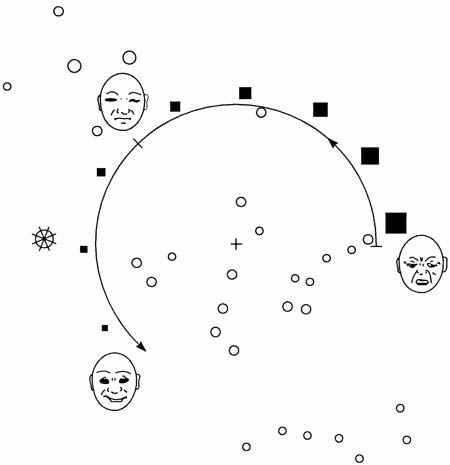Helvíti skemmtileg lesning: A Timeline of Timelines. Sjá þennan sæta mola:
..en þessi tímalína snýst vitaskuld að miiiklu leyti um kristin hindurvitni einsog nákvæma dagsetningu sköpunar Jarðarinnar. Og svoleiðis.
Og þetta hér:
Hvernig ætlarðu að búa til tákn sem merkir ,,geislun"? Kannske er það hérna einhverstaðar, ég veit ekki..

Örvarnar gera okkur það nokkuð ljóst að við eigum að fara rangsælis kringum krossinn (jafnvel þótt hárið komi aldrei til með að vaxa aftur), en hvaða litlu hringir eru þetta?
-b.
1658
Three years after La Peyrère's Praeadamitae, the Jesuit missionary Martino Martini published the first Chinese chronology in the West: Historiae sinicae decas prima. Father Martini based his work on the traditional Chinese chronologies and came to the shocking conclusion that authentic Chinese history goes back to the year 2952 B.C., i.e., 600 years prior to the year fixed by the Hebrew Bible for the Great Flood. This meant that China had to be inhabited long before the flood. Martini did not try to reconcile Biblical with Chinese chronology, but many of his successors did: Martini's work had demonstrated the importance of the use of Chinese historical records, and such records and their interpretation henceforth became a crucial ingredient of world chronologies.[Thanks to Professor Urs App for this entry]
..en þessi tímalína snýst vitaskuld að miiiklu leyti um kristin hindurvitni einsog nákvæma dagsetningu sköpunar Jarðarinnar. Og svoleiðis.
Og þetta hér:
2000
Throughout the late 20th century, professional semioticians struggle with the problem of constructing an iconographic language capable of communicating radiation dangers long after the death of current languages. Several of these symbolic systems are prepared for nuclear facilities, including the US government nuclear waste storage facility at Yucca Mountain, Nevada.
Hvernig ætlarðu að búa til tákn sem merkir ,,geislun"? Kannske er það hérna einhverstaðar, ég veit ekki..

Örvarnar gera okkur það nokkuð ljóst að við eigum að fara rangsælis kringum krossinn (jafnvel þótt hárið komi aldrei til með að vaxa aftur), en hvaða litlu hringir eru þetta?
-b.
1 ummæli:
Fönkí stöff og fríkuð mynd.
Sérstaklega skemmtileg myndin af þessum ólínulegu frásögnum úr Tristram Shandy:
http://www.cabinetmagazine.org/issues/13/assets/images/timelines/tristramShandy1.jpg
...voðalega pómó eitthvað. Jafnvel prepómó? Bleh.
Skrifa ummæli